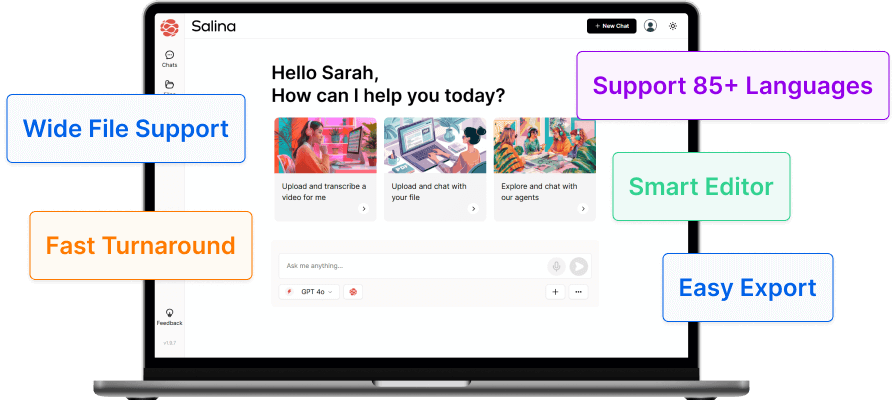Expanding your brand into new markets requires more than just translating your content. It demands a comprehensive content localization strategy that resonates with diverse audiences and maximizes global reach. Let’s explore how to effectively localize content and ensure your brand’s message connects with local markets.
During a solo trip to Toronto, I decided to explore the city on foot rather than taking the TTC, Toronto’s public transit system. I was 16, fresh out of high school, and eager to reconnect with the city where I was born. I wanted to immerse myself in the vibrant energy of the streets, feeling the pulse of the city firsthand. As I wandered through neighborhoods, I stumbled upon the Art Gallery of Ontario and the Hockey Hall of Fame, each offering a unique glimpse into the local culture and history.
This journey taught me the value of experiencing a place intimately, understanding its nuances and rhythms. Similarly, when brands expand into new markets, they must walk the streets of local culture, adapting their strategies to resonate with the unique preferences and traditions of each audience. Just as my exploration of Toronto required me to engage directly with the city’s essence, content localization demands a deep dive into the cultural landscape to truly connect with new markets.
What does content localization mean?
Content localization is the process of adapting content to meet the linguistic and cultural needs of a target market. It goes beyond simple translation to include modifying style, imagery, currency, and tone to align with local customs and preferences. The aim is to make content feel familiar and relevant to the local audience, enhancing engagement and brand perception.
The Reddit thread above offers valuable insights into the intricacies of localizing Japanese media, emphasizing the need to adapt cultural nuances like regional accents thoughtfully. For example, substituting a Japanese rural accent with a Southern drawl in English can effectively convey similar cultural connotations. Exploring the discussion further provides a deeper understanding of these challenges and highlights the importance of skilled localization in making content resonate with diverse audiences while preserving its original intent.
With a clear understanding of content localization’s importance, let’s explore a step-by-step guide to building an effective strategy for entering new markets.
How to Build a Content Localization Strategy: A Step-by-Step Guide
1. Conduct Market Research and Cultural Analysis
To effectively localize content, it’s essential to conduct thorough market research and cultural analysis. This step involves understanding the cultural landscape of your target market to ensure your content resonates with local audiences.
Understand Cultural Sensitivities
Research cultural symbols, colors, and phrases that might have different meanings in your target market. This understanding helps avoid cultural missteps that could alienate your audience. For example, while white is associated with purity in Western cultures, it is often linked to mourning in some Asian cultures.
Identify Local Trends
Stay informed about current trends and popular media in your target market. This involves analyzing what content is currently engaging the audience and understanding the strategies of local competitors. By aligning your content with local trends, you can increase its relevance and appeal.
Analyze Consumer Behavior
Examine how consumers in the region interact with brands, focusing on their preferred content formats and platforms. Are they more engaged with video content, long-form articles, or social media? Gathering insights from engagement metrics and consumer feedback will help tailor your content strategy to meet local preferences.
2. Define Your Localization Goals
Setting clear localization goals is crucial for guiding your strategy and measuring success. These goals should align with your overall business objectives to ensure cohesive growth.
Set Specific Objectives
Determine the specific outcomes you want to achieve through localization, such as increasing brand awareness or boosting sales in a particular region. Clearly defined objectives provide direction and focus for your localization efforts.
Align with Business Goals
Ensure that your localization objectives support broader business goals. This alignment ensures that your localization strategy contributes to overall company growth and provides a framework for evaluating success.
3. Prioritize Content for Localization
Not all content needs to be localized immediately. Prioritizing content based on its potential impact ensures efficient use of resources.
Identify High-Impact Content
Focus on localizing content that will have the most significant influence, such as product pages, marketing materials, and customer support resources. Prioritizing high-impact content ensures that your localization efforts are both effective and efficient.
Evaluate Return on Investment
Consider the potential return on investment for each piece of content. By focusing on content that offers the greatest potential benefits, you can maximize the impact of your localization efforts and ensure a positive outcome.
4. Choose the Right Localization Tools
Selecting appropriate localization tools is essential for streamlining the process and maintaining quality. These tools can automate tasks and ensure consistency across languages and formats.
Research Available Tools
Investigate various localization platforms and tools that offer features like AI-powered translation, content repurposing, and multimedia localization. Selecting the right tools can significantly enhance the efficiency and effectiveness of your localization efforts.
Ensure Consistency and Quality
Choose tools that help maintain consistency and quality across all localized content. Consistent terminology and style are crucial for building a cohesive brand image in new markets.
5. Develop a Content Repurposing Strategy
To maximize the reach and impact of your localized content, develop a strategy for repurposing it into various formats.
Adapt Content for Different Formats
Convert written content into videos, infographics, or social media posts tailored to specific platforms and cultural preferences. This approach ensures that your message is accessible and engaging across different media.
Tailor Content to Cultural Preferences
Consider the cultural preferences of your target audience when repurposing content. By aligning your content with local tastes and consumption habits, you can enhance its appeal and effectiveness.
A comprehensive content localization strategy enables effective engagement with diverse audiences by aligning content with local sensibilities and business objectives, while prioritizing high-impact content and using the right tools to streamline the process. Additionally, a content repurposing strategy maximizes reach and engagement across formats, enhancing your brand’s global presence.
While these steps provide a solid foundation for developing a content localization strategy, it’s valuable to examine real-world examples of successful localization efforts. One particularly noteworthy case study is Coca-Cola’s strategy in Japan, which demonstrates how effectively applying localization principles can lead to remarkable success in a foreign market. By analyzing Coca-Cola’s approach, we can gain practical insights into the implementation of localization strategies and their potential impact on brand performance in new cultural contexts.
Coca-Cola’s Content Localization Success: Adapting Products and Marketing for Japan

The Problem
Coca-Cola faced significant challenges when entering the Japanese market. The company had to contend with strong traditional beverage preferences, particularly for tea, and navigate a unique cultural landscape that differed greatly from Western markets. Additionally, Coca-Cola needed to establish a foothold in a highly competitive and saturated beverage market while overcoming the perception of being a foreign brand in a market that values local products.
Action
To address these challenges, Coca-Cola implemented a multi-faceted localization strategy. The company introduced Georgia Coffee, a canned cold coffee product tailored to Japanese preferences, tapping into the growing local demand for coffee. Coca-Cola’s marketing campaigns were carefully crafted to align with Japanese cultural values, employing local celebrities and creating messages that emphasized quality and tradition. They also leveraged Japan’s unique vending machine culture to ensure widespread product availability, investing heavily in this popular retail channel. Furthermore, Coca-Cola consistently evolved its product offerings to meet changing consumer preferences, including introducing low-sugar and black coffee varieties as tastes shifted.
Result
The results of Coca-Cola’s localization strategy in Japan were impressive. Georgia Coffee became the highest-grossing ready-to-drink coffee product in the world, and Coca-Cola quickly emerged as a market leader in the ready-to-drink coffee segment in Japan. The company maintained a competitive advantage for nearly two decades, from 1975 to 1992. Today, Coca-Cola owns around 980,000 of Japan’s 2.5 million beverage vending machines, capitalizing on high foot traffic and impulse buying. Most importantly, the brand successfully established itself as a local favorite, overcoming its initial perception as a foreign entity.
Lessons Learned
Coca-Cola’s success in Japan offers several valuable lessons for companies seeking to expand into new markets. Thorough market research is crucial for understanding local preferences, consumption habits, and cultural nuances. Willingness to adapt core products or create new ones to suit local tastes can significantly boost market acceptance. Aligning marketing strategies and brand messaging with local cultural values and traditions helps create a strong emotional connection with consumers. Identifying and leveraging local distribution channels effectively ensures product accessibility and visibility. Maintaining relevance in a dynamic market requires ongoing product development and adaptation to changing consumer preferences. Finally, successful localization often requires significant time and resource investment to establish a strong market presence.
These insights underscore the importance of understanding and adapting to local cultural contexts when expanding into new markets. By aligning offerings with cultural preferences and utilizing appropriate distribution strategies, companies can significantly enhance their chances of success in foreign markets. Tools like Salina can facilitate this process by ensuring that content is not only translated but also culturally adapted, making it resonate with local audiences and helping businesses effectively navigate the complexities of global expansion.
Taking Action with Salina
Amidst the challenges of localization, Salina emerges as an essential ally, ensuring that your brand’s content is culturally adapted and resonates with audiences across all markets. By transforming the approach to global brand communication, Salina offers solutions that enhance engagement with diverse audiences worldwide. With this support, brands can be confident that their content will remain relevant and impactful, regardless of cultural context.
How Can Salina Help You?
Cultural Content Adaptation
Salina uses advanced tools to adjust figures of speech, idioms, and metaphors so they make sense in different cultures. This ensures your content connects with local audiences in a genuine way, making it more impactful and appealing. By focusing on the details of different languages and cultures, Salina ensures your brand’s message is not just translated but also fits well with the target market.
Multimedia Localization
Videos, audio, and text content are translated smoothly, ensuring they fit cultural contexts on a large scale. This means you can adapt your content to local cultures, making it more effective in different markets. With support for over 28 file formats like MP4, WAV, PDF, and DOCX, Salina simplifies the translation process for complex multimedia projects, maintaining clarity and avoiding redundancy.
Local Market Fit
Content is adjusted to suit local cultures, enhancing its impact and appeal. This goes beyond simple translation to reshape the main message, ensuring it truly connects with your audience. Salina’s AI-powered translation speeds up entering new markets, allowing you to translate content into multiple languages quickly and efficiently. This not only extends your brand’s reach but also ensures your message is relevant and effective.
AI-Powered Content Repurposing
Salina helps turn translated content into different formats, maximizing your content’s reach by transforming one piece into multiple tailored versions for different platforms. By automating tedious translation tasks, it boosts productivity and lets your team focus on bigger goals. The cloud system can handle more work and multiple projects at once, so you can meet growing content demands without slowing down.
By focusing on these capabilities, brands can effectively navigate the complexities of cultural adaptation and localization. Salina not only enhances engagement with diverse audiences worldwide but also ensures that your brand’s message is heard and understood across the globe. This revision aims to create a seamless transition from the strategic steps to the practical application of those strategies using Salina, enhancing the overall coherence and flow of your blog.
Key Takeaways
- Content localization involves adapting content to align with local customs and cultural nuances.
- Extensive research and understanding of the target market are crucial for successful localization.
- Tools like Salina simplify the localization process across various platforms and formats.
- Coca-Cola’s success in Japan highlights the importance of cultural adaptation in product development, marketing, and distribution.
What’s Next
The future of content localization lies in taking advantage of AI and advanced technologies to make the process more efficient and scalable. By staying ahead of localization trends and refining strategies, brands can ensure sustained global growth. Exploring more case studies and tools will further optimize localization efforts, ensuring your brand remains relevant and impactful across all markets.




